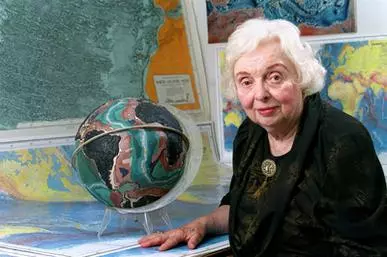
Google celebrates iconic cartographer Marie Tharp with a doodle
text_fieldsAmerican geologist and oceanographic cartographer Marie Tharp is one of the iconic figures of the 20th century. The Library of Congress named her one of the greatest cartographers on this day in 1998.
Google is celebrating her achievements with an interactive doodle. Once clicked on it, it leads to an illustration of Tharp standing in front of a map. The voiceover says her groundbreaking maps changed the way humans view the planet. It goes on to say she started her career in the 1950s when much of the land on Earth was already mapped but the ocean remained a mystery.
The slideshow further states: "Scientists began to study it using the newly invented sonar. They pinged the ocean floor and used the bouncing sound waves to calculate depth." The accompanying slide allows the user to click on any point and get a demonstration of how sonar works.
The presentation reveals that in the early days of Marie's research, boat captains were superstitious about having women on board. She had to rely on reports from her colleague Bruce Heezen and the rest of the team. Using the data they provided, she drafted height profiles of the Atlantic Ocean floor. Where data were insufficient, she relied on her maths background to interpolate.
While analysing the data, she realised all her height maps showed the same dip which led her to conclude there must be a rift running across the ocean floor. This indicated a continental drift which was an unpopular geological theory at the time. Her colleague Bruce was sceptical and erased Marie's work and asked her to redo it.
He infamously dismissed her findings as "girl talk."
The second draft she made also showed the rift. This led to her working with Howard Foster who had been mapping earthquake activity in the same area. They decided to overlay their maps. The patterns matched and the theory of continental drift was proved. However, the scientific community remained unconvinced despite Marie and Bruce publishing papers and giving talks.
Sceptical scientists started using a newly invented underwater camera to uncover the truth about the ocean floor once and for all. This led to the discovery of the mid-Atlantic Ridge and its rift valley.
Marie continued her work and made intricate maps that changed the fundamental understanding people had about the planet's history. Her findings laid the foundation for research on plate tectonics on how the Earth moves and changes over time. Researchers still rely on her work to conduct studies.
Marie's father who worked at the US Department of Agriculture introduced her to mapmaking. In 1948, she became the first woman to work at the Lamont Geological Observatory. In 1957, Tharp and Heezen co-published the first map of the ocean floor in the North Atlantic. 20 years down the line, National Geographic published the first world map of the entire ocean floor done by the same duo.
Marie Tharp considered her work as a jigsaw puzzle to piece together and it was a rare opportunity for a woman in the 1940s.























